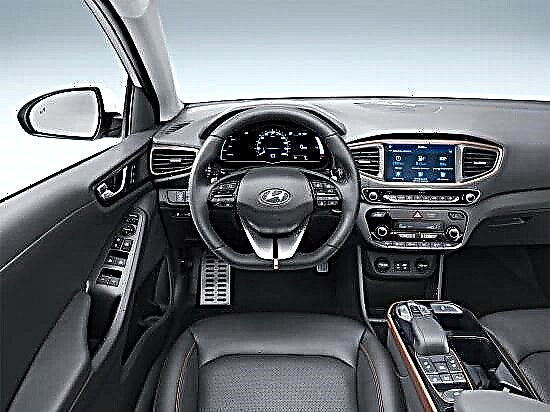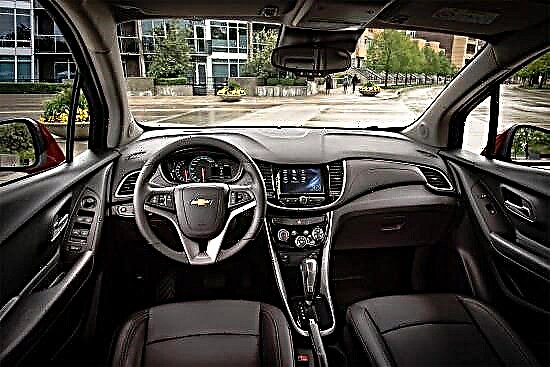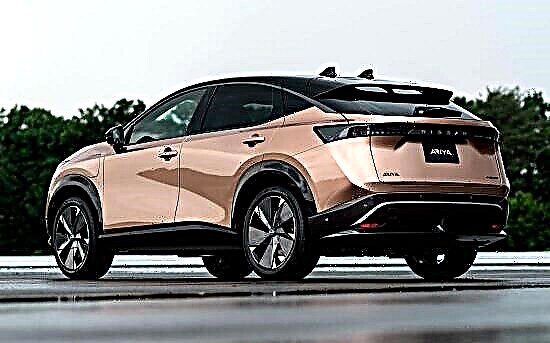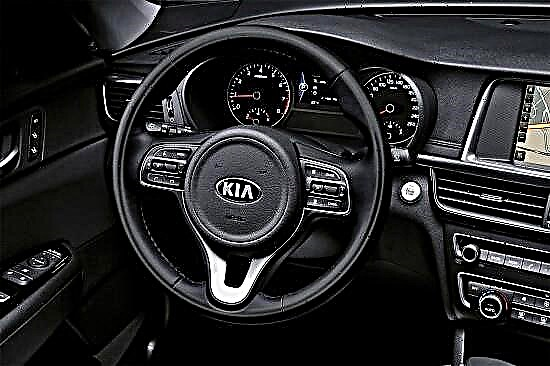Kia Optima is a front-wheel drive four-door sedan of the mid-size category (aka class "D +" by European standards), which is positioned in the company itself as a representative of the "business" segment, and is not far from the truth, since it is a really large car with an elegant design, modern technology, balanced "driving" potential and reasonable redundancy in terms of equipment ...
The main target audience of the three-volume is well-off middle-aged and older men who hold management positions of "middle management" or run their own business, who do not pursue pathos, image or status and are not going to overpay for a brand, or successful youth, for which one of the decisive factors when choosing a car is just the same design ...
The international premiere of the KIA Optima "globally fourth" (but "second" for Russia) generation thundered in April 2015 on the stage of the New York Auto Show, however, the car made its debut in the European specification only in September of the same year, but not only in conventional versions, but also in the "warmed up" GT-modification.
Compared to its predecessor, the car has gone through evolutionary changes - it has become more solid and swift in appearance, but retained its recognizable appearance, grew in size, received a seriously modernized technical "filling" and replenished its functionality with a bunch of new options.

This "Optima" again reached the Russian market with a slight delay - in early March 2016, but immediately with a "local registration", since in February 2016 its assembly was launched at the Kaliningrad plant "Avtotor".
In the spring of 2018, at a car show in Geneva, a restyled three-volume box appeared before the general public (although it was shown in its homeland at the end of January under the name K5), however, the update itself turned out to be very modest - the four-door was slightly adjusted to the exterior and interior, and also added new options to the equipment list.
Outwardly, the second generation KIA Optima looks beautiful, stately, proportional and dynamic - the sedan looks surprisingly well combined with some presentability with a bit of sportiness, which makes it really draw attention to itself, even against the background of more prestigious cars.

The energetic front end of the four-door "flaunts" predatory narrowed headlights, a "tiger nose" radiator grille with vertical louvres (but in the "top" versions - with a honeycomb structure) and a raised bumper with a "mouth" of the air intake.
In profile, the car is distinguished by a dynamic silhouette a la "four-door coupe" with heavily littered rear pillars, powerful sidewalls, a weighty rear and large cutouts of wheel arches, and its taut rear is decorated with graceful two-section lights and a solid bumper with one or two (depending on the modification ) oval exhaust pipes.

It is worth noting that the sedan is available in GT Line and GT versions, which can be recognized by more aggressive bumpers, a developed diffuser with a pair of oval tailpipes, wheel rims of the original design to the corresponding nameplates.
Dimensions and weight
In general, the KIA Optima of the "second" generation is in the D-segment according to European standards, but in terms of dimensions it can already be attributed to the E-class: the length of the four-door is 4855 mm, of which the wheelbase occupies 2805 mm, and its width and height reach 1860 mm and 1485 mm respectively. The vehicle's ground clearance is 155 mm.
And its curb weight varies from 1530 to 1755 kg (depending on the version).
Interior
The interior space of KIA Optima "second" incarnation is another of its strong points: inside the car looks attractive, presentable and logical in a European way.

Directly in front of the driver is a "plump" multifunctional steering wheel with a three-spoke rim and exemplary informative "horizontal" instruments with a pair of analogue scales and a "window" of the on-board computer between them, and a solid center console, slightly turned towards the driver's side, is crowned with an 8-inch touchscreen of the media system and laconic blocks of an audio system and an air conditioner. True, in the initial versions, everything is much simpler: a two-din radio tape recorder or a 7-inch screen of a multimedia complex and an unpretentious "stove" unit (of course - with air conditioning).
The salon of the "second" generation KIA Optima has five seats, and not only in words, but also in deeds. Front riders here rely on "universal" seats with widely spaced side support bolsters, a long cushion, moderately hard filler and a wide range of adjustments (by default, there is only heating on the front row, but there is also an electric drive, ventilation and memory as an option). On the "gallery" there is a commendable space for three adult passengers, and the sofa itself has a really comfortable profile, and the floor tunnel protrudes slightly inside.

The trunk of the "second" KIA Optima is roomy - its volume in normal condition is 510 liters, which is quite acceptable by the standards of the class, but the hinges eat up a good share of the space, and for fixing the cargo there are only a pair of Velcro straps in the pocket on the left side and a few hooks. Fortunately, the back of the second row folds in two unequal parts (in the ratio "60:40") into an almost flat area, and the opening to the salon turns out to be quite bearable.

In addition, in a niche under the raised floor, there is a full-size spare wheel on a cast disc and the necessary minimum of tools, neatly arranged in a Styrofoam organizer.
Specifications
In the Russian market, the KIA Optima of the "second" generation is offered with three four-cylinder gasoline engines with an in-line layout, a 16-valve DOHC timing chain with a chain drive and variable valve timing:
- The "younger" version is a 2.0-liter (1999 cc) "naturally aspirated" MPI Nu series with distributed fuel injection, which generates 150 horsepower at 6500 rpm and 196 Nm of torque at 4800 rpm.
- It is followed in the hierarchy by a naturally aspirated GDI engine (Theta II family) with a working volume of 2.4 liters (2359 cc) with direct injection and phase shifters at the inlet, producing 188 hp. at 6000 rpm and 241 Nm of peak thrust at 4000 rpm.
- The "top modification" GT is equipped with a "four" T-GDI series Theta II of 2.0 liters (1998 cc) with turbocharging, direct injection and low-noise timing chain, which produces 245 hp. at 6000 rpm and 350 Nm of torque at 1400-4000 rpm.
A six-speed manual gearbox is offered only for a 150-horsepower unit, but a 6-band “automatic” fits into all power plant options: the A6MF2 transmission works with the aspirated 2.0 and 2.4 liters, and the A6LF2 (capable of “digesting” a larger torque).
Speed, dynamics and consumption
Acceleration from 0 to 100 km / h takes 7.4-10.7 seconds for the car, and its maximum capabilities are 202-240 km / h.
In the combined cycle of movement, the three-volumetric consumes on average from 7.7 to 8.5 liters for each "hundred" (depending on the version).
Design features
The second generation KIA Optima is based on the Hyundai-KIA LF front-wheel drive platform, which it shares with the seventh Hyundai Sonata. The car "flaunts" a monocoque body, the power structure of which is more than half of high-strength grades of steel.

On both axles of the four-door, independent suspensions with anti-roll bars are used: at the front - McPherson type, at the rear - a multi-link system with telescopic hydraulic shock absorbers.

By default, the car is equipped with a rack and pinion steering with an electric power amplifier located on the steering shaft, but in the GT modification, this very EUR is on the rail. All wheels of the sedan are equipped with disc brakes (ventilated on the front axle), which are complemented by various electronic "assistants" (ABS, EBD, BAS).
Options and prices
On the Russian market, the "second" Kia Optima is offered in seven versions to choose from - Classic, Comfort, Luxe, Prestige, Premium, GT Line and GT.
A car in the basic configuration with a 2.0-liter "aspirated" and 6-speed "mechanics" will cost from 1,364,900 rubles, and the list of its equipment includes: six airbags, 16-inch alloy wheels, air conditioning, ABS, EBD, ESC, ERA-GLONASS system, four electric windows, light sensor, LED DRLs, heated front seats, electric drive and heated side mirrors, electric heated windscreen washer nozzles, an audio system with six columns, cruise control and multi-steering wheel.
A sedan with an 188-horsepower engine can be purchased at a price of 1,724,900 rubles (starting with the Luxe version), dealers want a minimum of 1,904,900 rubles for the sporting GT Line version, and the top-end GT modification costs from 2,074,900 rubles.
In the maximum version, the car can additionally boast: a knee airbag, fully LED headlights, a dual-zone "climate", a rain sensor, a drive mode select system, a media center with an 8-inch screen, front and rear parking sensors, keyless entry and start motor, heated steering wheel and rear seats, premium "music" Harman / Kardon with ten speakers and a subwoofer, 18-inch wheels, panoramic roof, electric sunroof, all-round cameras, blind spot monitoring and other "chips".











